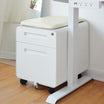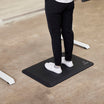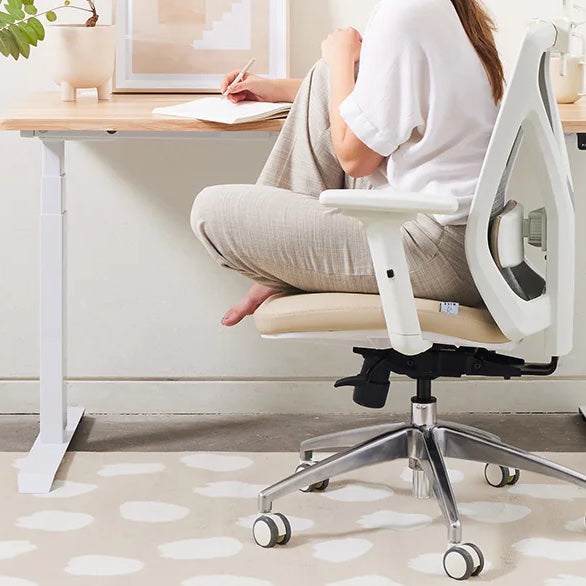Standing desks are becoming increasingly popular these days. They allow us to stand instead of sitting at our desk, thus avoiding the harmful effects of sitting for prolonged periods of time. But just how effective is a standing desk at improving one's health? Does using a standing desk burn calories?
Standing desks have been around for quite some time now. In fact, they were first used in Japan during the Edo period (1603-1867). The idea behind them was that people would be able to work while standing up rather than sitting down all day long. This way, they could avoid the negative effects of sitting on their back and legs.
However, it wasn't until recently that standing desks became more common among office workers. And today, they're even being used by athletes who want to improve their performance, or those who simply want to reduce the risk of developing certain diseases such as diabetes and heart disease.
But does using a standing desk really help you lose weight? Is it better than sitting at your desk all day long? Read on to find out.

How Does Sitting All Day Long Affect Your Health?
Sitting for extended periods of time has become an epidemic in modern society. It seems like everyone is glued to their computer screens from morning till night, which brings a flurry of issues to the table.
And this isn't necessarily an entirely bad thing. After all, we use computers to do things like get important work done, research and learn about our passions, read about news and special interests, play games, and more. But the consequences of sitting for so long are too dire to continue on without finding a solution.
Consequences of sitting for prolonged periods of time include:
1) Increased Risk of Heart Disease
According to the American Heart Association, prolonged sitting can increase the risk of cardiovascular disease. This includes high blood pressure, stroke, and heart attack.
2) Weight Gain
The same association also states that prolonged sitting increases the risk of obesity. This means that if you spend most of your waking hours sitting, then there's a good chance that you'll gain weight over time.
3) Diabetes
Prolonged sitting can also lead to type 2 diabetes. According to the Centers for Disease Control and Prevention, approximately 29 million Americans currently suffer from diabetes. And according to the World Health Organization, this number will rise to 366 million by 2030.
4) Cancer
Prolonged sitting can also cause cancer. According to the National Cancer Institute, sitting for more than six hours per day increases the risk of colon cancer by 40 percent. Similarly, sitting for more than eight hours per day increases the chances of breast cancer by 30 percent.
5) Depression
A study conducted by the University College London found that sitting for longer than two hours per dayincreased the likelihood of depression by 50 percent.
6) Alzheimer's Disease
A study published in the journal Neurology showed that sitting for more than four hours per day increases the odds of developing dementia by 70 percent.
7) Osteoporosis
Another study published in the Journal of Bone and Mineral Research found that women who sit for more than five hours per day have a higher risk of osteoporosis.
8) Muscular Pain
If you've ever experienced pain in your lower back after sitting for a long time,then you know how painful it can be. The reason behind this is because when you sit for a long period of time, your muscles start to atrophy. When this happens, your body doesn't receive enough oxygen and nutrients to function properly. As a result, your muscles begin to ache.
9) Back Problems
If you sit for a long time every day, you may experience back problems. A study published in the British Medical Journal found that people who sat for more than seven hours per day had a 60 percent greater chance of havingchronic low-back pain as compared to those who sat for less than three hours per day.
10) Joint Pain
Sitting for long periods of time causes joint pain. This is because your joints need to move frequently in order to stay healthy. However, when you're constantly sitting, they don't have anywhere to go. As a result, they become stiff and sore.
11) Carpal Tunnel Syndrome
When you're constantly typing or using a computer mouse for extended periods of time, your wrists and hands can become very uncomfortable.One of the symptoms of carpal tunnel syndrome is numbness, tingling, and weakness in your fingers, hand, and wrist.
12) Shoulder Pain
Sitting for too many hours each day has been proven to make your shoulders feel like they're on fire. Why? Because your shoulder blades are right next to one another, and when you're hunched over all day, they get strained.
13) Neck Pain
Your neck needs to be free in order to avoid injury. But when you're staring at a screenall day, your head begins to take a toll on your neck. Over time, your neck becomes weak and sore.
14) Headaches
Headaches are caused by stress, poor posture, and tension. All of these things increase when you're sitting down for prolonged periods of time. In fact, studies show that people who spend more than 11 hours per week seated have an increased risk of getting headaches.
15) Heartburn/Indigestion
Have heartburn or indigestion issues? You might not realize it,but sitting too much can actually cause them. If you're spending most of your day sitting, your stomach gets cramped, which leads to gas and other digestive issues.
16) Sleep Apnea
Have trouble falling asleep? Sitting for too long before bedtime could be the culprit why. According to statistics, around 18%of adults suffer from sleep apnea, and 75% of them aren't even aware they have it. Studies show that people who spent more than six hours per day sitting were about 3 times more likely to develop sleep apnea.
And this is not even an exhaustive list. Sitting for extended periods of time wreaks havoc on your body and mind.
We already know that switching to a sit-to-stand routine not only curbs these effects, but offers endless benefits for your health and mind. But is one of those weight loss? What does this mean in terms of calories?

Does using a standing desk burn calories?
The short answer: Yes. The longer answer: It depends.
If you’re looking to lose weight, then yes, using a standing desk will help you do so. But if you’re trying to gain muscle mass, then no, it won’t necessarily help you build muscle.
To understand how using a standing desk affects your calorie intake, we first need to look at what happens when you stand up.

How Does Standing Up Help Weight Loss?
When you stand up, your muscles contract. And as soon as your muscles contract, they start burning calories.
This means that every time you stand up, you burn calories. So if you stand up for 30 minutes three times per day, you’ll burn approximately 90 calories.
But here’s where it gets tricky.
Standing up doesn’t just burn calories; it also helps you burn fat. How? By increasing your metabolism.
A study published in the Journal of Obesity found that after subjects stood up for 20 minutes, their metabolic rate increased by 7%. This means that they burned more calories throughout the rest of the day.
So while standing burns calories, it also increases your overall metabolism. Which means you burn more calories throughout the day.

Is That Enough To Lose Weight?
Yes!
In fact, according to a study conducted at the University of Wisconsin, standing up for just 10 minutes burns enough calories to equal the amount of energy needed to lose 1 pound of weight.
That said, there’s a caveat.
While standing up for 10 minutes burns enough calories, it may not be enough to make a difference in your weight loss goals.
Why? Because standing up for 10 minutes isn’t going to change your lifestyle habits.
You still need to eat less and exercise more.

What About Muscle Gain?
While standing up for 10 minutes is enough to boost your metabolism, it’s not enough to build muscle.
According to a study published in the International Journal of Sports Nutrition & Exercise Metabolism, standing for 15 minutes didn’t leadto any significant changes in muscle growth.
Which means that if you want to build muscle, you need to spend more time standing up.
For example, if you stand up for 45 minutes instead of 10, you’ll increase your metabolism by 14%, which is enough to double your muscle gains.
However, keep in mind that standing up for 45 minutes might not be realistic.

The Bottom Line
Using a standing desk can help you lose weight, and offers a treasure trove of transformative effects on your body and mind. However, it’s unlikely to have a direct effect on your body composition.
























